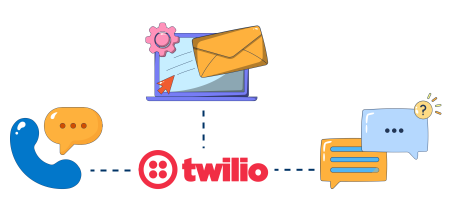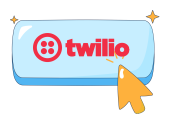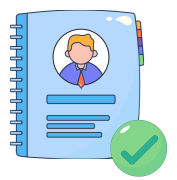Founded in 2008 by Jeff Lawson, Evan Cooke, and John Wolthuis, Twilio started with a simple idea: make it easier for software to talk to people. What began as an API for sending SMS has evolved into a full-scale cloud communications platform. Today, Twilio supports everything from voice calls to WhatsApp messaging and customer engagement products like Segment and Flex.
Twilio isn’t just a tech company; it’s where innovation meets real-world impact. From powering text alerts for Lyft rides to enabling video chats on health care apps, Twilio’s tools are behind some of the most seamless daily communication experiences. The platform offers voice, messaging, video, email, and user verification APIs, making it easier for developers to build scalable, real-time solutions.

Whether you’re pursuing an engineering, product, data science, or developer-relations position, understanding each stage of Twilio’s interview journey will help you confidently walk in. In this blog, we’ll break down every step, from the initial recruiter chat to the final offer, and share practical tips to help you succeed.
Why join Twilio?
What truly makes Twilio stand out isn’t just its technology; it’s the culture behind it. It’s a place where developers are heard, ideas are encouraged, and learning never stops. Known for its strong developer-first culture, commitment to inclusion, and passion for building meaningful tools, Twilio attracts top talent worldwide. Companies like Uber, Reddit, Dell, and Shopify trust Twilio, and thousands of developers trust it.
Twilio’s commitment to diversity, equity, and inclusion, and unique “Draw the Owl” mindset drive team norms and hiring.
Let’s quickly go over a few more reasons why Twilio stands out as an employer:
- Build APIs and tech used by millions.
- Work in a diverse, collaborative, and mission-driven team.
- Learn from expert mentors and top resources.
- Enjoy flexible remote or hybrid work options.
- Be part of fast-paced, high-impact projects.
- Contribute to the success of global brands.
- Get great benefits and real work-life balance.
Navigating the Twilio interview process step by step
Understanding what’s ahead can help us navigate the Twilio interview process, whether we’re applying for an engineering, product, or another role.
Step 1: The application and resume screening
This phase is your entry point into Twilio’s world. You can apply for any open role on Twilio’s career portal.

Recruiters sift through applications to match your skills and experience with the job requirements. They look for relevant tools, technologies, and demonstrated impact. Successful candidates proceed to the next phase.
Creating a resume that catches a recruiter’s attention is essential, so let’s look at some key tips for crafting a strong one.
Resume strategies:
- Tailor your resume to each role by mirroring keywords in the job description.
- Quantify achievements, e.g., “Reduced API latency by 40%,” “Directed cloud migration raising uptime to 99.9%,” or similar.
- Highlight technologies relevant to your role. For example, engineering candidates should highlight terms like APIs, Python, Node.js, AWS, microservices, or popular web frameworks.
- Prioritize clean, readable formatting for quick skimming.
What about cover letters? Not always required, but a short, focused cover letter can boost your application. In your cover letter, you can:
- Mention what draws you to Twilio, such as a specific product, aspect of the culture, or a value like “Draw the Owl.”
- Connect your most substantial achievements to the role’s requirements.
- Show alignment with Twilio’s core values, such as creative problem-solving or customer focus.
Step 2: Recruiter screen
In this call, the recruiter reviews your background, career motivations, and reasons for choosing Twilio. They’ll give you an overview of the role, team dynamics, and Twilio’s culture. You should expect culture-fit questions and discussions around job expectations.

Step 3: Technical assessment/take‑home test
Depending on the role, you may receive:
- A HackerRank or similar coding challenge, usually 2 to 4 problems.
- A take‑home project (common for developers or PMs) to complete within a time frame, e.g., 10 business days.
Step 4: Technical phone interview
This stage is approximately 45 to 60 minutes long. It is conducted live with an engineer or hiring manager. Often, you solve 1–2 algorithmic problems on a shared coding platform. They evaluate you on your problem-solving approach, coding clarity, and ability to communicate trade-offs.
Step 5: On‑site or virtual interview loop
This phase typically involves 4 to 6 back-to-back interviews over half a full day, with breaks built in.
It includes:
- Live coding rounds: Expect more questions on data structures, algorithms, and problem-solving techniques. Be prepared to solve coding problems, review code, or handle debugging tasks.
- System Design: This is mainly for mid to senior engineering roles. You can expect questions that test your ability to design scalable, reliable, and maintainable systems. Be ready to draw diagrams, discuss data flow, and address trade-offs like scalability or security.
- Behavioral or cultural fit: This part of the interview focuses on working with others, making decisions, and responding to challenges. Twilio looks for candidates who align with its values, such as customer obsession, empowering others, and curiosity. Prepare STAR‑structured stories about empowerment, handling ambiguity, and supporting your teammates.
- Bar‑raiser interview: This final round is typically conducted by a senior leader who may not be part of the immediate team. They aim to objectively assess your overall fit and ensure you’re qualified and a good fit for the company. Expect questions that assess your long-term potential, alignment with company values, and ability to contribute at a high level across teams.
Step 6: Decision and offer
The Twilio team typically extends an offer within ~48 hours of final interviews. The recruiter or talent partner shares details on compensation and benefits (such as time off, “No Meeting Fridays”, and remote-first policies) and guides you through the next steps.
How to prepare for Twilio interviews
Here’s how to boost your chances of succeeding in Twilio interviews:
- Master the technical fundamentals: Coding, System Design, or case solving. Practice various interview questions on platforms like Educative, LeetCode, or HackerRank.
- Practice interviews and simulate the process: Practice interviews with peers or through platforms like Pramp or Educative’s mock interview.
- Demonstrate Twilio’s values: Familiarize yourself with operating principles like “Draw the Owl” (figuring things out with limited direction), “Empower Others,” and “Be Inclusive.” Be ready with examples where you’ve solved challenging problems, supported others, or thrived under pressure.
Helpful resources for your interview prep
You can use these resources to strengthen your skills to succeed in interviews:
- Grokking the Coding Interview Patterns: Master 28 essential coding patterns to solve a wide range of coding interview questions.
- Grokking the Low-Level Design Interview Using OOD Principles: A proven guide to object-oriented design (OOD) interviews, created by engineers from top tech companies. Master OOD fundamentals and practice real-world interview questions to prepare with confidence.
- Grokking the Modern System Design Interview: The ultimate guide to the System Design Interview. Master distributed system fundamentals and practice with real-world interview questions and mock interviews.
- Grokking the Behavioral Interview: Whether you’re a software engineer, product manager, or engineering manager, this course will give you the tools to prepare thoroughly for behavioral and cultural questions.
- Grokking the Product Architecture Design Interview: The essential guide to API design and product design interviews. Master product design fundamentals and get hands-on with real-world APIs.
Twilio’s interview process is thoughtfully structured to find candidates who are a good fit both technically and culturally. If you’re excited about building communication tools that matter, show up prepared and stay true to your approach. Being curious and genuine can help you stand out. With the right effort, joining the team at Twilio is within reach. Good luck!
